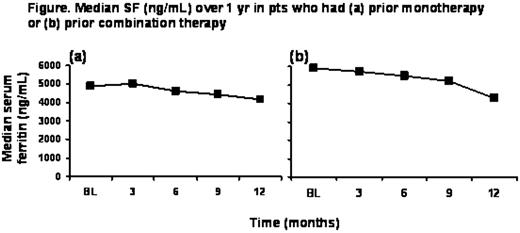Abstract
Abstract 4058
Poster Board III-993
Despite the availability of effective chelators, many patients (pts) with β-thalassemia major (TM) present with high iron burden and serum ferritin (SF) >2500 ng/mL, demonstrated to be associated with significant negative outcomes including cardiac disease and organ failure. In the large, prospective EPIC trial including 854 TM pts who received prior chelation therapy, median baseline SF was 3139 ng/mL despite 10.8 yrs of therapy; hence the therapeutic goal was to reduce iron burden. Previous studies have shown that in TM pts with high transfusional iron, ≥30 mg/kg/day deferasirox (Exjade®) doses significantly reduce SF, while 20 mg/kg/day doses maintained SF levels. The objective of this analysis was to assess whether a mean actual deferasirox dose ≥30 mg/kg/day is effective in reducing SF in iron-overloaded pts with TM irrespective of prior chelation therapies.
Pts with TM (≥2 yrs) and transfusional iron overload as defined by SF levels ≥1000 ng/mL or <1000 ng/mL but with a history of multiple transfusions (>20 transfusions or 100 mL/kg of blood) and R2 MRI-confirmed liver iron concentration >2 mg Fe/g dry weight were enrolled. Initial deferasirox dosing (10–30 mg/kg/day) was dependent on transfusion requirements and adjusted according to the protocol by 5–10 mg/kg/day (range 0–40 mg/kg/day) every 3 months based on SF trends and safety markers. Pts previously chelated with monotherapy deferoxamine (Desferal®; DFO) or deferiprone (Ferriprox®; DFP) or a combination of both and who received a mean actual deferasirox dose ≥30 mg/kg/day over 1 yr were included. The primary efficacy endpoint was the change in SF at 1 yr from baseline (BL).
Overall, 129 TM pts (15%) who were previously chelated with DFO and/or DFP were treated with a mean actual deferasirox dose of ≥30 mg/kg/day during the 1 yr EPIC trial; 83 pts received prior DFO or DFP monotherapy and 46 received a combination of both. Mean age was 19.5±8.2 vs 23.0±7.2 yrs in prior monotherapy and prior combination therapy pts, respectively. A mean of 167 mL/kg vs 191 mL/kg was transfused in the yr prior to study entry and the mean duration of prior chelation therapy was 11.7±7.7 yrs vs 14.5±7.9 yrs, respectively. During the study, mean transfusional iron intake was similar in both groups (0.36±0.2 and 0.34±0.1 mg/kg/day, respectively). In prior monotherapy pts (mean dose 33.9±2.2 mg/kg/day), median SF decreased from 4885 ng/mL at BL to 4282 ng/mL after 1 yr (Figure) resulting in a decrease from BL of 1024 ng/mL (P<0.0001) based on last-observation-carried-forward (LOCF) analysis. In prior combination therapy pts (mean dose 34.1±3.9 mg/kg/day), median SF decreased from 5921 ng/mL at BL to 4327 ng/mL (Figure) resulting in a decrease from BL of 886 ng/mL (P=0.0078; LOCF). In patients with labile plasma iron (LPI) at BL, 1.3±2.1 and 1.7±3.1 μmol/L in the prior monotherapy and combination therapy groups, respectively after 1 yr was reduced to 1.1±2.6 and 1.4±2.7 μmol/L (LOCF).
Overall, five pts (3.9%) discontinued therapy. Reasons for withdrawal were adverse events (AEs; cardiac failure), abnormal laboratory values (increased transaminases), consent withdrawal, lost to follow-up and protocol violation (all n=1). The most common investigator-assessed drug-related AEs were rash (n=14, 10.9%) and diarrhea (n=12, 9.3%). One pt (0.8%) had serum creatinine >33% above BL and the upper limit of normal (ULN) on two consecutive visits and one pt (0.8%) had increased alanine aminotransferase >10xULN on two consecutive visits; levels were already elevated.
This heavily transfused subgroup of TM pts, who had received prior chelation therapy with DFO and/or DFP for an average >10 yrs, continued to have high SF levels >4500 ng/mL. Monotherapy with ≥30 mg/kg/day deferasirox for 1 yr led to significant and clinically relevant reductions in SF in these pts irrespective of previous chelation therapies and was well tolerated. Longer-term studies are required to assess whether continued deferasirox could reduce SF <2500 ng/mL to minimize serious complications of iron overload.
Taher:Novartis: Honoraria, Research Funding. Chan:Novartis: Honoraria, Research Funding. Li:Novartis: Consultancy, Speakers Bureau. Lin:Taiwan Pediatric Onclogy Group (TPOG): Consultancy; Novartis: Honoraria, Speakers Bureau. Porter:Novartis: Membership on an entity's Board of Directors or advisory committees, Research Funding, Speakers Bureau; Vifor International: Membership on an entity's Board of Directors or advisory committees. Sutcharitcharan:Novartis: Honoraria, Research Funding; Novo Nordisk: Honoraria. Habr:Novartis Pharmaceuticals: Employment. Domokos:Novartis Pharma AG: Employment. Roubert:Novartis Pharma AG: Employment. Cappellini:Novartis: Membership on an entity's Board of Directors or advisory committees, Speakers Bureau; Genzyme: Membership on an entity's Board of Directors or advisory committees.
Author notes
Asterisk with author names denotes non-ASH members.


This feature is available to Subscribers Only
Sign In or Create an Account Close Modal